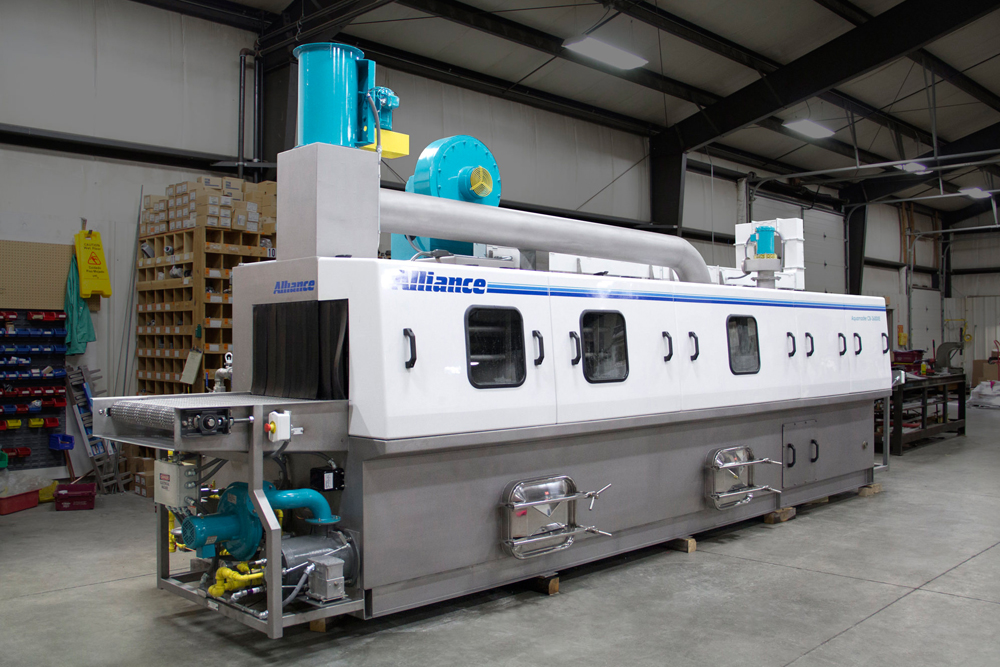Manufactured parts and manufacturing processes are all very custom, and therefore, the parts washing equipment that cleans these parts needs to be sized properly for the application in order to meet the level of cleanliness required through an efficient and cost-effective design.
One of the most common requests that Alliance sales engineers hear from our customers is to design a parts washer that will clean their parts, yet fit within a given floor space requirement. While this request seems innocent enough, specific information on the part cleaning requirements must be obtained from the customer before the final machine design and size can be determined.
There are five key pieces of information that the customer must provide in order to determine which parts washer design should be utilized: 1) part profile, 2) production rate, 3) contamination to be removed, 4) cleanliness requirement, and 5) dryness requirement. Once this information is obtained, both the parts washer design and overall size can be determined.
Usually, the combination of all five key factors will indicate which parts washer model would be best suited to fulfill the customer’s cleaning needs, whether the washer is a high-production inline belt, indexing, or a low-production cabinet washer.

Once the model of parts washer has been determined, the next step is to design the washer to provide the output needed to meet the customer’s production requirement.
- Part profile: The part size, design complexity, and material all are needed to determine the design and size of the washer. In addition, how the parts are processed through the washer will have an impact on zone lengths (i.e. conveyor belt vs. indexing) and conveyor belt widths. The part complexity is also critical in the washer design, since a more complex part design may require special spray and blowoff consideration.
- Production rate: The production rate, or cycle time, is the number of parts within a given period of time to be cleaned. Higher or continuous production rates will require the use of either an inline belt or indexing machines. Parts with lower or intermittent production rates can be batch washed in cabinet-style washers.
- Contamination: The type of contaminant on the part will play a role in the length of time needed for cleaning. Coolants and light oils will require less exposure time within the wash, resulting in a shorter zone. Heavy oils and grease will require additional exposure time within the wash to break down and remove the soils, resulting in slower belt speed and/or a longer zone length.
- Cleanliness requirement: One of the most critical components in determining the design and size of a parts washer is the part cleanliness requirements. Cleanliness requirements can be in the form of total mass, particle size, particle quantity, a combination of all three, or simply “visually clean.”
- Dryness requirement: The part dryness requirement also plays an important role in determining the design and size of the washer. If some residual moisture is acceptable on the parts as they exit the washer, an ambient blowoff module may be sufficient in the drying process. However, if the parts must exit the machine completely dry, the use of a heated blowoff module will be required. This is particularly important with lighter parts and/or faster conveyor speeds. In addition, based on the part design complexity, additional air knives or compressed air nozzles may be installed at critical areas of the part in order to achieve dryness.
Other factors also come into play when determining the design and size of the washer are: 1) belt vs. indexing, 2) pump GPM (gallons per minute) and blower CFM (cubic feet per minute) requirements, and 3) energy source use to heat the solution and blowoff air.
- Belt vs. Indexing: A conveyor belt is the most common design utilized for the majority of parts cleaning applications, for non-complex part designs or non-critical cleanliness requirements. An indexing washer may be required due to part complexity, production rate, and cleanliness requirements. In an indexing washer, directed spray nozzles and targeted compressed air nozzles are used to clean and dry critical part cavities. Indexing washers can either be manufactured in an inline or rotary design, with manual parts loading/unloading or utilizing automation.
- GPM/CFM: The design of the washer will dictate both the GPM and CFM requirements. A larger washer will demand more GPM in the wash/rinse zones and the design or size of the blowoff zone will dictate the CFM requirements.
- Energy source: While electric heat is most common on the majority of washers, larger washers demand a high rate of GPM and CFM usage where it becomes more cost-efficient to utilize natural gas as the heat source.
Our sales and engineering team utilize their many years of combined experience when analyzing each parts washer application. In most cases, our design concept will fit within the customer’s floor space requirements.